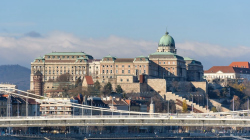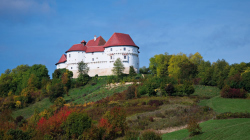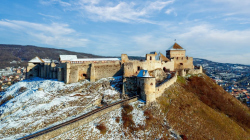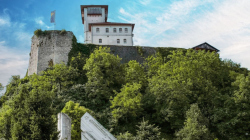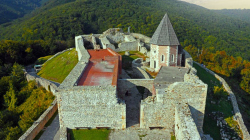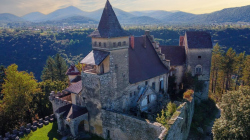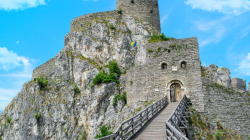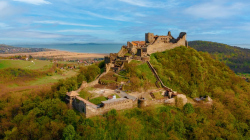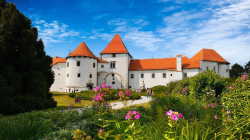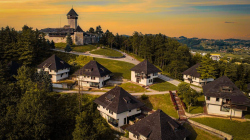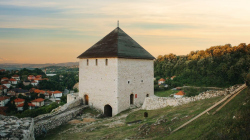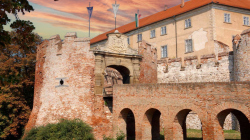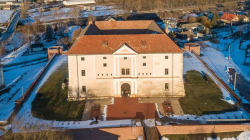Day 1: Budapest castle and historical center (Breakfast)
Visit Buda Castle, the main Budapest attraction. Admissions not included.
Walk in Budapest historical center.
Day 2: Bory - Szigliget (Breakfast)
One of two self-built castles in Hungary (the other is the much more ramshackle Tarodi Var), The Bory Castle In Szekesfehervar was the work of Hungarian sculptor and architect Jeno Bory. Bory built the castle between 1923 and 1959 with the help of several of his students. (Admissions not included)
Next, we move to see famous ruins of Castle Szigliget. The settlement existed in the Neolithic and Bronze Ages. Celtic, Roman and Avar archaeological finds were discovered in the vicinity. The ruins of a parochial church, built in the 12th century, can be seen. Until 1822 the area was an island in Lake Balaton. The island was connected to the mainland in 1822 by rearrangement of the bank-dams around Balaton. Castle Szigliget The ruins of the medieval fortress stand atop the 239m Várhegy hill. Recently restored, the castle looks out on a panorama of Lake Balaton toward the Tapolca Basin. Poets have praised the beauty of the village and landscape.Castle Szigliget The ruins of the medieval fortress stand atop the 239m Várhegy hill. Recently restored, the castle looks out on a panorama of Lake Balaton toward the Tapolca Basin. Poets have praised the beauty of the village and landscape.
Day 3: Sümeg - Varaždin (Breakfast)
The Sümeg castle is located in the town of Sümeg, about 20 kilometers north of Lake Balaton, in Hungary. The Sümeg castle was built in the mid or late 13th century and is situated at the top of a lonely mountain peak called "Castle Hill". During its existence, it has been expanded several times. In the 15th century, it was fortified, and the second of two towers was built. It has been under siege several times, and has experienced two fires. (Admissions not included)
Varaždin is a city in Northern Croatia, 81km north of Zagreb. The town is mainly known for its baroque buildings, music, food and IT industry. The most interesting from tourist point of view is Varaždin Castle in the Old Town. (Admissions not included)
Day 4: Trakoscan - Veliki Tabor (Breakfast)
Castle is located in northern Croatia, in the Varaždin County, and dates back to the 13th century. Admissions not included. 2 hours • Admission Ticket Not Included 2 Dvor Veliki Tabor Veliki Tabor is a castle and museum in northwest Croatia, dating from the middle of 15th century. The castle's present appearance dates back to the 16th century. (Admissions not included)
Day 5: Medvedgrad - Zagreb (Breakfast)
Medvedgrad is a medieval fortified town located on the south slopes of Medvednica mountain, approximately halfway from the Croatian capital Zagreb to the mountain top Sljeme. For defensive purposes it was built on a hill, Mali Plazur, that is a spur of the main ridge of the mountain that overlooks the city. On a clear day the castle can be seen from far away, especially the high main tower. (Admissions not included)
The capital and the largest city of Croatia, lively and with a rich history dating from the Roman times, Zagreb is located in the northwest of the country, along the Sava river, at the southern slopes of the Medvednica mountain. Zagreb is an important tourist centre because of its culture, arts, music, architecture, gastronomy among other things.
Day 6: Zagreb (Breakfast)
This day is devoted to historical center of Zagreb.
Day 7: Dubovac - Velika Kladusa - Ostrožac (Breakfast)
The Dubovac Castle overlooks the Croatian city Karlovac. The oldest part, square tower was built during the 13th century. In the 15th century, the castle was rebuilt in a renaissance style. The Dubovac castle had various owners, from Slavonian nobleman family to famous Croatian counts and dukes. In 1837, a new owner, Count Laval Nugent, rebuilt the castle in the spirit of romanticism. The Dubovac castle was once again renovated in 1952 in relation to graphics from the end of the 18th century. (Admissions not included)
Velika Kladuša is a town and municipality located in Una-Sana Canton of the country Bosnia and Herzegovina. It is situated in the far northwest of Bosnia and Herzegovina, located near the border with Croatia. The Velika Kladuša fortress was built in the Middle Ages and was first mentioned in 1280. The fortress was occupied by the Ottomans in 1633, pass many fights, and was last point of defense of Bosnia's armed resistance against occupying Astra-Hungarian army in 1878. Admissions not included.
Ostrožac castle is located in Bosnia and Herzegovina in the Una-Sana Canton just outside the town of Cazin, near the village of Ostrožac. The castle dates back to the 16th century when the Ottoman Turks established the Ottoman province of Bosnia. A second addition was made to the castle between 1900 and 1906 by an unconfirmed member of the Habsburg family. (Admissions not included)
Day 8: Ostrovica - Ključ (Breakfast)
The Ostrovica Castle is a large medieval structure situated above the small village of Ostrovica near Kulen Vakuf, Bihać municipality, Bosnia and Herzegovina. Having been built on a woody ridge of a steep hill overlooking left bank of the shallow Una river, the castle was located on a strategic site connecting the northern and southern parts of the long Una valley. The Modern-day castle was built most probably in the 15th century on the foundations of ancient fortification which dates back to ancient Roman times or even earlier. (Admissions not included)
The Old Town Kljuc is the pearl of our medieval heritage and architecture and represents an invaluable cultural asset of great historical value. He played a significant role in the history and politics of the medieval Bosnian state, and his masters were powerful nobles from the river valley of the Sana. The medieval town Kljuc consists of 3 parts: a) the Lubica Tower from the 13th century, b) the Ottoman tower camp, c) the medieval town on the Sana River (this is lower part of the town with capitula, palace, garden. (Admissions not included)
Day 9: Banja Luka - Tešanj (Breakfast)
This beautiful and historical city surrounded by green hills, split into two by the Vrbas river. Banja Luka is the second largest city, after the capital Sarajevo, of Bosnia and Herzegovina and the capital of the Republika Srpska entity. It has a rich mixture of preserved architecture combined with a rich culture that give Banja Luka a unique charm. It's one of Bosnia's most modern and up-and-coming cities. To protect the route Salona-Servitium the Romans built a fortress (Kastel Fortress) here (in the center of the city). When the Roman Empire collapsed, the Slavs took over. Once the Ottomans finally controlled the town, they gave it a distinct oriental style. During the Ottoman glory days were built bridges, mills and plenty of mosques. (Admissions not included)
Castle Tešanj castle is located in the town Tešanj, on the territory of Bosnia & Herzegovina. Tešanj castle was built in the center of Tešanj, on a steep and rocky hill, along the river, and known as a medieval and Ottoman fortress. Currently, Tešanj Castle is one of the most significant and biggest castles in Bosnia, with an area of 6,296 square meters. (Admissions not included)
Day 10: Srebrenik (Breakfast)
Srebrenik fortress is located near the town of Srebrenik, on the territory of Bosnia & Herzegovina. Currently, Srebrenik fortress is country's best-preserved medieval castle. The fortress was built on a high, steep and almost inaccessible rock above the valley of the Tinja River. The rock rises from the surrounding terrain at a height of about 50 to 70 m. A deep excavation was made below the most accessible part of the fort, so that access is only possible through the bridge. (Admissions not included)
Day 11: Gradačac (Breakfast)
Gradačac castle was constructed with 2 main parts: a fort with 18 meters high walls, and a watchtower 22 meters high, all built in by Bosnian hero Husein-kapetan Gradaščević. Gradačac castle was built on the strategic hill that dominates the amazing landscape. The impressive fortress with 18 meters-high walls was constructed between 1756 and 1821, on the old Roman foundations, while the watchtower called Gradina 22 meters-high was built in 1824. The tower served as a military complex, but also city administration premises. Below the castle there is a hidden underground system of tunnels, that were used for defense purposes while ago and only recently got rediscovered. (Admissions not included)
Day 12: Siklos (Breakfast)
The castle of Siklós, which guards the southern border of Hungary, was the residence of the most important noble families in medieval Hungary. The first record related to the castle of Siklós is in a certificate dated back to 1294. Perched on a hillside, the impressive structure of this castle dominates the southernmost town of Hungary, the town Siklós. (Admissions not included)
Day 13: Ozora (Breakfast)
Ozora is a village in Tolna, Hungary, not far from famous lake Balaton. It has been notable since the Middle Ages, when Pipo of Ozora built a outstanding renaissance castle at this site by permission of Sigismund of Hungary in 1416. The Ozora castle was built in the 15th century by Filippo Buondelmonti degli Scolari (also known as Pippo Spano), Italian magnate, general, strategist and confidant of King Sigismund of Hungary. Being one of the few Renaissance buildings, the castle is a real gem. The castle was able to survive through ages, despite of all the Ottoman – Hungarian Wars in the Middle Ages. (Admissions not included)
Day 14: Departure
Departure date of end of our service.
 Register
RegisterSign in Travel Agent
Sign in Supplier
Sign in Affiliate
Sign in Guru

